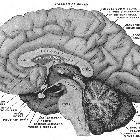choroid plexus metastases


Metastases to the choroid plexus from extracranial tumors are rare, but nonetheless should be included in the differential diagnosis of an intraventricular mass. They are most commonly found within the lateral ventricles, presumably because a large proportion of the choroid plexus is located there.
Epidemiology
Choroid plexus metastases account for <5% of intracranial metastases in autopsy series, and <1% of clinically evident cerebral metastases . They are seen most commonly in adults, although have also been found in children with extracranial childhood tumors.
Pathology
Tumor spread to the choroid plexus may occur through a haematogenous route via the anterior or posterior choroidal arteries , or through CSF seeding .
Tumors most likely to metastasize to the choroid plexus are renal cell carcinoma and lung cancer. Other tumors with documented spread to the choroid plexus include colon, gastric, breast, thyroid, and bladder cancers, melanoma, lymphoma, and carcinoma of the esophagus .
When seen in the pediatric population, metastases to the choroid plexus have been reported to arise from Wilms tumor, neuroblastoma and retinoblastoma.
Radiographic findings
Choroid plexus metastases may be seen on CT or MRI as either a solitary lesion, or as a component of disseminated intracranial metastatic disease. Reported complications which may be found on imaging include hydrocephalus and hemorrhage from an intraventricular metastasis .
CT
Imaging appearance is variable. The lesion may be hypo or isodense on non-enhanced CT, and may demonstrate moderate or marked enhancement, more commonly homogeneous .
MRI
MRI is more sensitive than CT in the detection of small choroid plexus lesions.
With larger lesions, there may be peritumoural edema or invasion into adjacent brain parenchyma.
Treatment and prognosis
These lesions may be amenable to surgical resection. Prognosis is variable and depends on the type and stage of the primary tumor, and extent of metastatic dissemination.
Differential diagnosis
The differential diagnosis is that of other intraventricular masses that may arise in the relevant age group. In an adult patient, consider:
- intraventricular meningioma: particularly at the trigone of a lateral ventricle
- colloid cyst: when at the foramen of Monro
- central neurocytoma
- subependymoma: particularly if there is poor enhancement
See also
- intraventricular masses (differential)
- intraventricular masses - an approach
Siehe auch:
- intraventrikuläre Neoplasien und Läsionen
- intraventrikuläre Blutung
- intraventrikuläres Meningeom
- intraventrikuläres Neurozytom
- intraventrikuläre Neoplasien und Läsionen - Überblick
- Tumoren des Plexus choroideus
- Foramen interventriculare Monroi
und weiter:

 Assoziationen und Differentialdiagnosen zu Metastasen des Plexus choroideus:
Assoziationen und Differentialdiagnosen zu Metastasen des Plexus choroideus:






